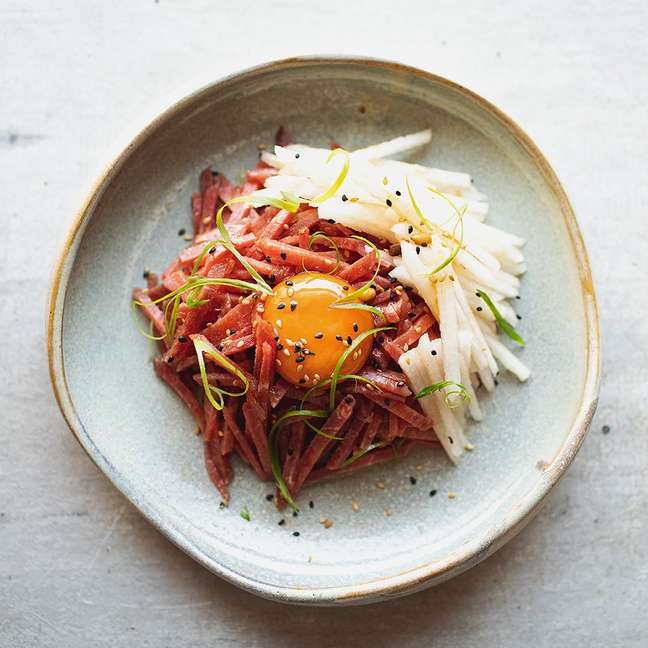The debate has gained traction on social media as chefs and critics have diverged opinions on the matter.

“Marketing gimmick”, “Grandma’s food”, “A warm hug”, “A big hoax”. These are some of the descriptions used by chefs and critics listened to by Paladar on affective gastronomy, the name given to cuisine that seeks memories of flavors and aromas linked to a person’s past through food. A controversy that has arisen in recent weeks, however, puts this cuisine in check: does emotional food really exist?
The big point of disagreement is in the way this gastronomy is viewed. After all, affective food assumes it will be a form of affection with the end customer. However, how can you ensure that this food item is related to that customer’s past? It may be that macaroni prepared in this way will remind one person of their grandmother, but they will not evoke any emotion in another who, in turn, will try it with a brigadeiro.
Ian Oliver, food critic of the Crítico Antigourmet profile, on Instagram, is against affective gastronomy. For him, in this case, it is necessary to differentiate cooking from gastronomy. “They’re totally different things,” he tells Paladar. “Cooking is a practice in the private world, in people’s homes. What is in the private sphere has no discourse, there is no possibility of criticism. Gastronomy is different. It is public food. It is the food that the restaurant brings us , open the doors, display your food to the public”.
With this, one cannot think of an affective gastronomy. It is not possible, according to Ian, that a public office touches what is most individual in a person: private life and tastes. “It is impossible for a chef to want to reach the emotional memory of 100 customers, 200 customers in one day. He may even average what he assumes to be an affective memory of Brazilians, but then falls into reductionism, mediocrity or stereotypical tawdry,” he says.
A similar scenario is observed by Jota Bê, food critic of Boteco do JB. “There are two scenes of affective food in the city: the simple and familiar activities whose served food recalls the diner’s childhood, thus activating affective memory; and there is a famous food scene that capitalizes on this kind of situation,” he says.
In addition to preparation
Despite the contrary opinions of Jota Bê and Ian Oliver, there are those who defend affective gastronomy – or, at least, see no reason for fierce criticism. This is the case of chef André Rochadel, gastronomy columnist for the Metrópoles portal. While the profile Crítico Antigourmet published a text in which it was said that “affection is the death of gastronomy”, Rochadel wrote an article saying the opposite: for him, chefs should bet on this type of food.
“Personally, I think the controversy stems more from what we consider affective gastronomy and also from frustration with its distortion. Like any aspect that becomes commercial, there is abuse of its use in incorrect situations. This happened with the term gourmet, with the contemporary and now the term emotional comes into play”, explains the chef.
According to him, the affection does not come from the preparation, but from the product. “[A gastronomia afetiva] it saves the simple processes, the enhancement of the product, the simplicity of the preparations”, he exemplifies. “It is with a few manipulations and a few processes that the ingredient is enhanced and the true talent of the cook is shown. It is being able to extract what is good in the product. An affective gastronomy for me is not exactly the one that reminds me of my grandmother’s chicken, but the one that gives a feeling of ’embrace’ in the stomach, of relaxation, of something simple and well done, just like you ate at home and in our homes. friends”.
Paulo Shin, chef of the Korean restaurant Komah, goes even further. “Each person has the reference of him. It could be from your grandmother, aunt, mother, or a restaurant you went to with someone you love. It’s complicated for people to take ownership and say it doesn’t exist,” says the chef. “I think emotional gastronomy has more to do with service. It refers to care, affection, tenderness. Whether it’s for the service, for the chef, for the dish. People go to canteens, for example. Technically there’s nothing, but it’s simple, it’s tasty and it’s very loving.”
Future of affective gastronomy
As affective gastronomy grows and more and more people seek out this “embracing” food, more and more restaurants try to join the wave. “We see quirks on menus like ‘il pudding della nonna’ and ‘la milanesa della mamma’ with the simple intention of riding the wave and charging for more. I think these should be ignored like any other excess,” Rochadel says.
André Mifano, chef of the Donna restaurant, understands that this is a commercial move, but sees the possibilities of the market with different eyes. “I think there is a complex scene in São Paulo, with a lot of competition, and deadlines come up from time to time to try and separate you from the crowd. Some people will benefit from some names and it is true. It’s too hard. Perhaps the word of time is affective. A few years ago it was molecular. Before it was homemade, it was simple. The industry always finds a word. The important thing is, whether it’s commercial or not, keep the emotion in the kitchen,” he says.
Interestingly, despite the different points of view on what affective gastronomy is, there is an absolute consensus among all the interviewees: this type of food has a future throughout Brazil.
“Often the affective cooking etiquette is used to compensate for gross technical errors. And this is gaining an audience. Many people believe in it. They believe that they will eat, feel hugged and have their memory revisited. There is an audience for everything,” there are people who want to be deceived. It’s an increasingly promising scenario,” says Ian, of the Antigourmet Critic. “It’s a captivating speech, it’s a very beautiful promise. But it has nothing to do with what gastronomy intends to do. It can grow, because there’s still a lot of room for it.”
Even Checho Gonzales, from Mescla, doesn’t criticize affective gastronomy and agrees with Paulo Shin: affection is in the treatment of the customer and this is part of the future of restaurants. “My clients increasingly need personalized service, when we remember people’s names, like in the old days. It has become a machine, there are 300-seat restaurants and people want that service close by. Here in Mescla, the salon it’s the extension from my house. I get paid like I get paid in my house. That’s the future,” he says.
+The best content in your email for free. Choose your favorite Terra newsletter. Click here!
Source: Terra
Ben Stock is a lifestyle journalist and author at Gossipify. He writes about topics such as health, wellness, travel, food and home decor. He provides practical advice and inspiration to improve well-being, keeps readers up to date with latest lifestyle news and trends, known for his engaging writing style, in-depth analysis and unique perspectives.







